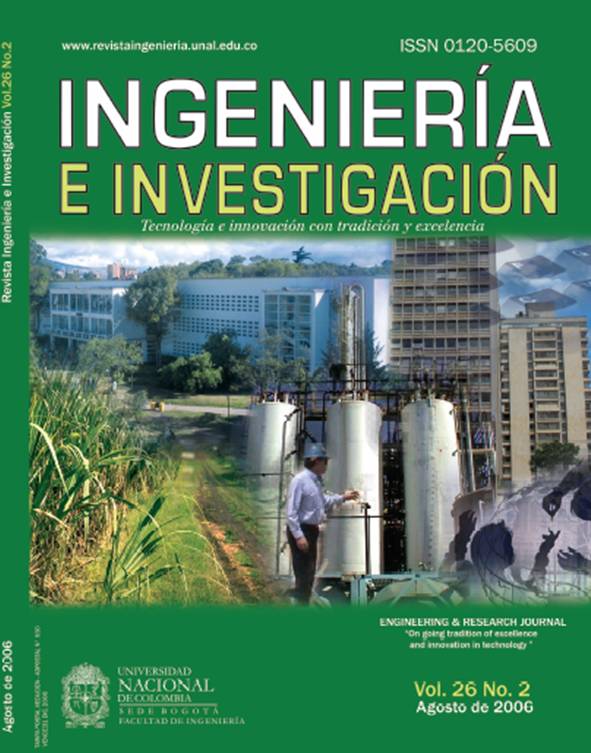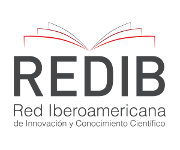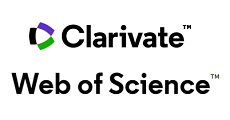Fe/SiO2 catalysts for the selective oxidation of methane to formaldehyde
Catalizadores Fe/SiO2 para la oxidación selectiva de metano hasta formaldehído
DOI:
https://doi.org/10.15446/ing.investig.v26n2.14735Keywords:
Fe/Si0 catalyst, formaldehyde, selective oxidation, sol-gel (en)catalizadores Fe/Si0, formaldehído, oxidación selectiva, sol-gel (es)
Downloads
Selective oxidation of methane to formaldehyde was analysed with iron catalysts supported on silica prepared by the sol-gel method, leading to obtaining a large support surface area facilitating high dispersion of iron on silica’s amorphous surface. Seven catalysts were prepared; one of them corresponded to the silica support and another five having an iron load 0.1-0.5% in weight. Catalyst 7 (0.5% Fe in weight) was prepared with neutral pH control and had the most homogeneous characteristics since it did not present isolated iron species, corroborated by SEM and TEM analysis. The highest BET areas were 1,757 and 993 m2.g-1 for 0.5% Fe catalysts, having an average 36% microporosity and 43% mesoporosity. X-ray diffraction confirmed the catalyst’s amorphous structure. Catalytic activity was carried out with catalyser 7 at atmospheric pressure in a quartz reactor using a CH4/O2/N2=7.5/1/4 reaction mixture at 400-750°C temperature range. Reaction products were analysed by gas chromatography with TCD. The heterogeneous catalysts displayed greater methane conversion (but with methanol selectivity) whereas homogenous catalyst 7 gave better results regarding formaldehyde. The highest conversion percentage (8.60% mol) for catalyser 7 was presented at 650°C. Formaldehyde selectivity was 50% mol in the 600-650°C range and maximum yield (0.31g HCHO/Kg catalyst) was found in this range; it was thus considered that 650°C for the reaction was thereby the best operating temperature.
La oxidación selectiva de metano a formaldehido fue analizada con catalizadores de hierro soportados sobre sílice preparados por el método sol-gel, el cual permite obtener gran área superficial del soporte facilitando una alta dispersión del hierro sobre la matriz amorfa de la sílice. Se prepararon siete (7) catalizadores, uno de ellos correspondiente al soporte de sílice, otros cinco (5) con cargas de hierro entre 0,1-0,5 % en peso. El catalizador No.7 (0,5% Fe en peso) se prepara con control de pH neutro y resultó de características más homogéneas ya que no se presentaron especies aisladas de hierro, corroborado por análisis SEM y TEM. Las áreas BET mayores son del orden de 1 757 y 993 m2.g-1 para los catalizadores de 0,5% Fe, con porcentajes promedio del 36% de microporosidad y 43% de mesoporosidad. La difracción de rayos X confirma la estructura amorfa del catalizador. La actividad catalítica es realizada con el catalizador No. 7 a presión atmosférica en reactor de cuarzo, mezcla de reacción CH4/O2/N2 =7.5/1/4, intervalo de temperatura 400-750°C. Los productos de reacción son analizados por cromatografía de gases con TCD. Los catalizadores heterogéneos presentan mayor conversión de metano pero con selectividad al metanol, mientras que el catalizador homogéneo No. 7 da mejores resultados en formaldehido. Para el catalizador 7, el porcentaje más alto de conversión (8,60 mol%) se presenta a 650°C. La selectividad al formaldehido está en 50 mol% entre 600-650°C y en este intervalo se encuentra el máximo rendimiento (0,31 g HCHO/kg catalizador), considerando así que la temperatura de operación es de 650°C.
References
Arena, F, Frusteri, F, y Parmaliana, A., Modelling the partial oxidation of methane to formaldehyde on silica catalyst., Applied Catalysis A: General, 197, 2000, pp.239-246. DOI: https://doi.org/10.1016/S0926-860X(99)00481-0
Arena, F., Frusteri, F, y Parmaliana, A., Partial oxidation of methane to formaldehyde: A theoric-Experimental Approach to Process Design and Catalyst Development., Journal of Catalysis, 207, 2002, pp. 232-236. DOI: https://doi.org/10.1006/jcat.2002.3527
Arena, F., Gatti, G., Coluccia S., Martra, G., y Parmaliana, A., Catalysis Today, 91-92, 2004, pp. 305-309. DOI: https://doi.org/10.1016/j.cattod.2004.03.049
Bañares, M.A., Alemany, L. J., López Granados, M., Faraldos M. y Fierro, J. L. G., Partial oxidation of methane to formaldehyde on silica-supported transition metal oxide catalysts., Catalysis Today, 33, 1997, pp. 73-83. DOI: https://doi.org/10.1016/S0920-5861(96)00099-5
Bedel, L., Structure et réductibilité de pérovskites La-Co-Fe. Application a la synthése Fischer-Tropsch., Thése de l’U.L.P de Strasbourg, France, 2002.
Chu, L., Tejedor-Tejedor, M.I., y Anderson, M.A., Particulate sol-gel route for microporous silica gels., Microporous Materials, 8, 1997, pp. 207-213. DOI: https://doi.org/10.1016/S0927-6513(96)00068-5
De Lucas, A., Valverde, J.L., Cañizares, P, y Rodríguez, L.., Partial oxidation of methane to formaldehyde over W/ SiO2 catalysts., Applied Catalysis, A: General, 184, 1999, pp. 143-152. DOI: https://doi.org/10.1016/S0926-860X(99)00102-7
Herman, R.G., Sun Q., Shi, C., Klier, K., Wang, Ch., Hu, H., Wachs, I.E., y Bashin, M.M.., Development of active oxide catalysts for the direct Oxidation of methane to formaldehyde, Catalysis Today, 37, 1997, pp.1-14. DOI: https://doi.org/10.1016/S0920-5861(96)00256-8
Kobayashi, T., Guilhaume, N., Miki, J., Kitamura N. y Haruta M., In situ Raman spectroscopy. A powerful tool for studies in selective catalytic oxidation., Catalysis Today, 32, 1996, pp. 171-175. DOI: https://doi.org/10.1016/S0920-5861(96)00173-3
Mendoza, D., y Barboza-Flores, M., Inorganic Materials. Vol. 38, No.1, 2002, pp. 45, 47. DOI: https://doi.org/10.1023/A:1013651411023
Nguyen, Y., y Roger, A., Etude préliminaire de l’oxydation partielle catalytique du méthane en formaldéhyde., Rapport de stage, ULP 2004.
Parmaliana, A., Arena, F., Frusteri, F, Martínez-Arias, A., López Granados, M., y Fierro, J. L. G., Effect of Fe-addition on the catalytic activity of silicas in the partial oxidation of methane to formaldehyde., Applied Catalysis A: General, 226, 2002, pp.163-174. DOI: https://doi.org/10.1016/S0926-860X(01)00897-3
Parmaliana, A., Arena, F, Sokolovskii, V., Frusteri F y Giordano N., A comparative study of the partial oxidation of methane to formaldehyde on bulk and silica supported MoO3 and V2O5 catalysts., Catalysis Today, 28, 1996, pp. 363-371. DOI: https://doi.org/10.1016/S0920-5861(96)00049-1
Predoi, D., Kuncser, V., Zaharescu, M., Keune, W., Sahoo, B., Valeanu, M., Crisan, M., Raileanu, M., Jitianu, A. y Fil G., Structural and magnetic properties of iron species/ SiO2 nanocomposites obtained by sol-gel methods., Phys.Stat.Sol.(c) 1, No. 12, 2004, pp. 3507-3510. DOI: https://doi.org/10.1002/pssc.200405492
Sánchez, F.J., Estudio de catalizadores y cinética para la oxidación selectiva de etanol a acetaldehído., Tesis Maestría en ingeniería química, Universidad de Nacional de Colombia, Bogotá, 1989.
Tongpool, R., y Jindasuwan, S., Sol-gel synthesis and characterization of iron oxide-silica nanocomposites., Surface and Interface Analysis, 36, 2004, pp. 1130-1132. DOI: https://doi.org/10.1002/sia.1857
How to Cite
APA
ACM
ACS
ABNT
Chicago
Harvard
IEEE
MLA
Turabian
Vancouver
Download Citation
CrossRef Cited-by
1. William Giovanni Cortés-Ortiz, Alexander Baena-Novoa, Carlos Alberto Guerrero-Fajardo. (2019). Structuring-agent role in physical and chemical properties of Mo/SiO2 catalysts by sol-gel method. Journal of Sol-Gel Science and Technology, 89(2), p.416. https://doi.org/10.1007/s10971-018-4892-7.
2. Carlos Alberto Guerrero Fajardo, Francisco José Sánchez Castellanos. (2009). Synthesising Fe-Mo catalysts supported on silica for the selective oxidation of methane to formaldehyde. Ingeniería e Investigación, 29(1), p.53. https://doi.org/10.15446/ing.investig.v29n1.15143.
Dimensions
PlumX
Article abstract page views
Downloads
License
Copyright (c) 2006 Carlos Alberto Guerrero Fajardo, Yvonne N’Guyen, Claire Courson, Anne Cécile Roger

This work is licensed under a Creative Commons Attribution 4.0 International License.
The authors or holders of the copyright for each article hereby confer exclusive, limited and free authorization on the Universidad Nacional de Colombia's journal Ingeniería e Investigación concerning the aforementioned article which, once it has been evaluated and approved, will be submitted for publication, in line with the following items:
1. The version which has been corrected according to the evaluators' suggestions will be remitted and it will be made clear whether the aforementioned article is an unedited document regarding which the rights to be authorized are held and total responsibility will be assumed by the authors for the content of the work being submitted to Ingeniería e Investigación, the Universidad Nacional de Colombia and third-parties;
2. The authorization conferred on the journal will come into force from the date on which it is included in the respective volume and issue of Ingeniería e Investigación in the Open Journal Systems and on the journal's main page (https://revistas.unal.edu.co/index.php/ingeinv), as well as in different databases and indices in which the publication is indexed;
3. The authors authorize the Universidad Nacional de Colombia's journal Ingeniería e Investigación to publish the document in whatever required format (printed, digital, electronic or whatsoever known or yet to be discovered form) and authorize Ingeniería e Investigación to include the work in any indices and/or search engines deemed necessary for promoting its diffusion;
4. The authors accept that such authorization is given free of charge and they, therefore, waive any right to receive remuneration from the publication, distribution, public communication and any use whatsoever referred to in the terms of this authorization.



























